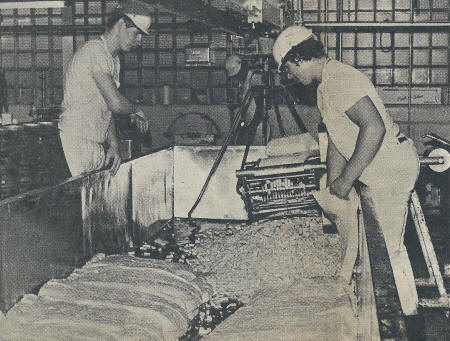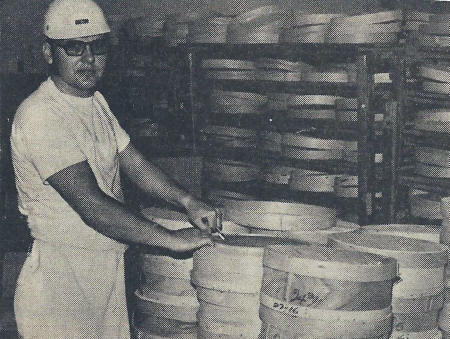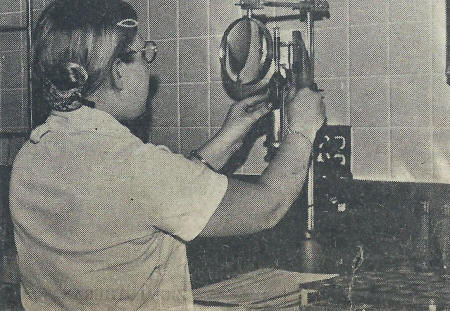Contact: Dolores (Mohr) Kenyon
E-mail: dolores@wiclarkcountyhistory.org
Surnames: Birkett, Zimmer, Varney, Rasmussen, Wilczek
----Source: Tribune Record Gleaner (Loyal, Clark Co., WI) 6/27/1974
Greenwood Milk Products (June - 1974)
Mingling with Mary (By Mary Woods)

General Manager for Greenwood Milk Products, Wayne Birkett. He became General Manager in 1968, and is also on the Board of Directors for Land O’Lakes.
Within the past three weeks the TRG has taken a look at the dairy profession in Clark County. Articles have been written about a farmer and co-chairman of Clark County June Dairy Month Committee, a farm wife, and the owner of an agri-business. In concluding the specials on June Dairy Month, Greenwood Milk Products Co-op has been chosen as a dairy business that has shown advancement of the years with dedication, concern, and belief in the patrons who they serve and who in return serve them.
Records show that the co-op began in 1932, when a group of farmers felt that large companies were taking advantage of them, and by forming a co-op this movement could be prevented. The farmers also felt that they were not receiving enough pay for their products and this could also be improved by the co-op. Each farmer was required to sing a three-year contract, and after the three years many of the farmers did drop out, but the co-op remained and continued to serve its patrons, and provide to the community an outstanding cheese factory.
At the present time, Greenwood Milk Products covers a radius of 25 miles with 235 patrons. According to Wayne Birkett, general manager of the co-op since 1968, - 39,000 pounds of cheese is made a day. The co-op processes cheese five days a week, with all cheese distributed by a marketing agency in conjunction with Land O’Lakes.
The three major types of cheese processed are Cheddar, Colby, and Monterey. The Monterey cheese is distributed primarily in California with the Colby and Cheddar distributed throughout the United States.

Working in the cheese making department of the co-op is left, John Zimmer and Robert Varney, on right. Both men are milling cheddar cheese.
Birkett states that during the month of June an added feature is June Daisies which are 23 pounds of cheese molded into circular form. He stated that 18-20,000 of the Daisies are processed during the month of June which is part of the highest milk production season. An average figure of 280,000 pounds of milk is collected daily for processing with a total of 77,404,665 pounds of milk received during 1973. From this figure 7,494,475 pounds of cheese was manufactured.
Other statistical facts from the report for the year ending December 31, 1973, shows that the average price received, of all cheese sold per pound, was 73.12 cents, with an operating expense of 10.32 cents per pound of cheese manufactured. The report also points out that 16,308 pounds of cheese was sold locally and 7,929 pounds of cheese was sold to Greenwood Milk Products Co-op patrons.
Turning to the advancements that have been made in the co-op, the most recent is that of the whey dryer. According to Birkett, the addition of the dryer plant became necessary after the Department of Natural Resources (DNR) began pushing the issue of pollution, in concern with means of whey being disposed. Prior to the dryer, the whey was picked up by Foremost Foods for animal food. Birkett points out that such action by the DNR has proven to be profitable, unlike the co-op had expected.
The process of drying the whey is very simple according to Birkett. “It is a process of vacuum and steaming the whey with a final outcome of a dried substance. Taking 100 pounds of whey would result in 85 pounds of water being removed and 15 pounds of concentrate remaining. The concentrate will then go to Northland Foods of Shawano for use in bakery goods, candy goods, and will also be used in powdered and skim milk products.

Checking the whey evaporator on the central control panel is Kris Rasmussen of Withee.
Turning back to the cheese portion of the co-op, Birkett was questioned about the present-day problem of cheese surplus and how it has affected the area plants. According to him the problem can be related to several factors, including the following: The milk pay-off in relationship to the Watergate Scandal, where the American Milk Producers Incorporated have been cited for wrong doings in President Nixon’s Campaign Funds; the lowering of meat prices has also affected the price of cheese, and the surplus, states Birkett. “When a person can buy two pounds of hamburger for the price of one pound of cheese, he most likely will take the hamburger. When the price of meat was high, people turned to dairy products as a means of stretching the budget, but now that the price of meat has come down, cost of dairy products remains the same, and a surplus has occurred.” Exporting of cheese has also been a factor in the pricing of cheese, according to Birkett. “A small percentage of exported cheese is inspected before it goes into processed cheese in the United States. Most of the cheese comes from New Zealand and Australia, with other countries in the Common Market exporting cheese into our country without meeting the same regulated standards that the factories have to meet here in the United States. Another point is that these countries are selling their surplus of cheese at a lower cost here, than they are in their own country, causing unfair competition.”
Italian cheese used to be very popular with pizza manufacturers. But now they are using more cheddar cheese for mixtures in the pizzas. Birkett also noted that the pizza fad had slipped off within the past year and this has also cut the need of cheese by this food industry. Perhaps the entire cheese market has not been affected by the drop-in pizzas, but the market has noted the change.

Joe Wilczek, plant superintendent from Greenwood is grading cheese prior to its storage and shipping.
Another reason noted for the surplus is that many butter and powdered milk plants have turned into cheese plants, causing more cheese production. Birkett notes that the cheese market usually does expect a surplus in late May and early June, due to milk production, but the market usually levels off within a few months, but is not expected to do so this time. If there wasn’t a surplus in the summer months when milk production is high, the winter months would not be able to supply the milk that is needed for chees processing, remarks Birkett.
Turning to the sale of milk and its effect on the cheese market, Birkett states that fluid milk sales have dropped, pushing that much milk back into cheese. Explaining this further, he noted that the energy crisis has cut the amount of milk that is needed in tourist states in the winter months, like Florida. Birkett continued to state that Florida, being a winter home for many, did not have the influx of tourist this past winter, and therefore the milk demand was lower in the state, and this in return affected milk sales in this area. Along with the energy crisis, it was noted by Birkett that transportation cost has also affected the cheese industry in the way that gas prices have increased which calls for more expense in transporting the cheese, causing cheese prices to raise.
Reflecting on the consumer and his part in the cheese surplus, Birkett states that the consumer wants small packages of cheese for convenience, and that packaging has become an expense, this reflection on the cost. Getting more to the farmer and the co-op, he explained that the price of milk has dropped for the farmer and the co-op, but prices in the stores continue to rise. This, according to Birkett, “is one phase that must be watched for, someone is making a gain, and it isn’t the farmer. The price and cost distribution is greatly out of proportion.”
Birkett also cited the political price of cheese, along with parity, as a reason for the cheese surplus. He stated that at this time, 85 percent parity is being paid by the government, and this is in need of increase.
As to the outcome of the cheese surplus and what it will do to the diary industries, Birkett explained, “in time the surplus and prices being paid to the farmer, and others directly involved, will put those businesses that are not financially strong, out of business. This is not only the farmer who sees higher expenses, but also the processor, and the small cheese factories. We are very fortunate at Greenwood Milk Products Co-op to be affiliated with Land O’Lakes, which is one of the largest cheese distributing companies. But for the small factories, the going is going to get rough, as we have already seen happen in the state. In time, maybe the price of cheese will recover and people will buy more. People must be aware of the nutritional food value in cheese, and dairy products, and use them more frequently. It’s all a matter of time as to how the cheese market will turn out for six months ago it was a problem in naming the price of your product, but if you don’t have a market agreement, it is a different story.”
“The farmer has survived other types of situations like the one that he is face with today. If he is strong he will survive and come out O.K., but it will be only those who are determined to fight for their rights, and the equality that is to be theirs that will come out ahead, states Birkett in a final note.
Greenwood Milk Products Co-op is aware of the problems that the farmer, and they face. They perhaps have encountered similar problems before – and have survived. They have seen the both the bad and the good sides of the dairy industries. They have grown with the times, and gave to the patrons the service that they were deserving of – for they are an asset to the Greenwood community and Clark County.

Darla Birkett, a senior at the Greenwood High School, tests cheese fat in the Greenwood Milk Products Co-op Lab.
